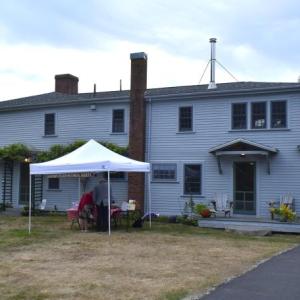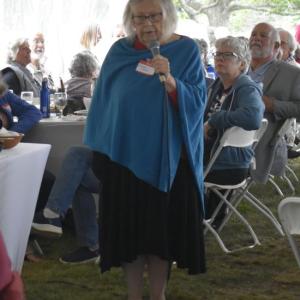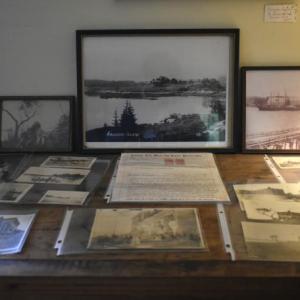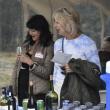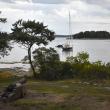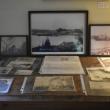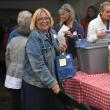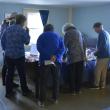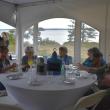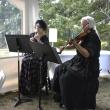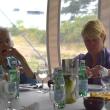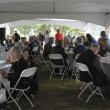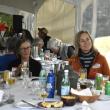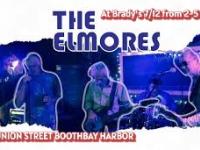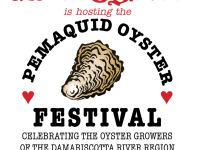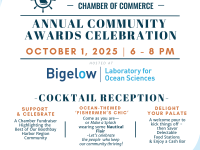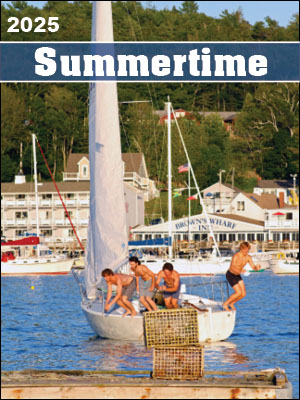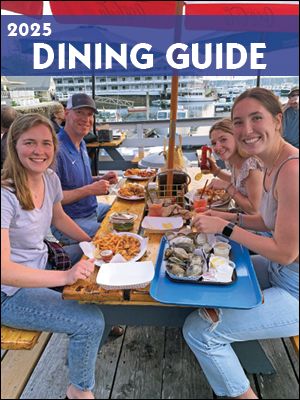Windows to the past are opened at Leach House
 Guests peruse Boothbay Region Historical Society artifacts during an event at Leach House. ISABELLE CURTIS/Boothbay Register
Guests peruse Boothbay Region Historical Society artifacts during an event at Leach House. ISABELLE CURTIS/Boothbay Register
 Leach House was once the site of a mid-18th-century tavern. ISABELLE CURTIS/Boothbay Register
Leach House was once the site of a mid-18th-century tavern. ISABELLE CURTIS/Boothbay Register
 Guests got to try both typical tavern food and drink. ISABELLE CURTIS/Boothbay Register
Guests got to try both typical tavern food and drink. ISABELLE CURTIS/Boothbay Register
 Salted cod balls! ISABELLE CURTIS/Boothbay Register
Salted cod balls! ISABELLE CURTIS/Boothbay Register
 A cannon from the War of 1812. ISABELLE CURTIS/Boothbay Register
A cannon from the War of 1812. ISABELLE CURTIS/Boothbay Register
 Sally Sewall receives flowers in thanks from BRHS. Pictured: Sally Sewall and BRHS Outreach and Development Manager Connie Hartley. ISABELLE CURTIS/Boothbay Register
Sally Sewall receives flowers in thanks from BRHS. Pictured: Sally Sewall and BRHS Outreach and Development Manager Connie Hartley. ISABELLE CURTIS/Boothbay Register
 Food historian Sandra Oliver talks tavern food. ISABELLE CURTIS/Boothbay Register
Food historian Sandra Oliver talks tavern food. ISABELLE CURTIS/Boothbay Register
 Archaeologist Tim Dinsmore shows off a typical 18th-century case bottle. ISABELLE CURTIS/Boothbay Register
Archaeologist Tim Dinsmore shows off a typical 18th-century case bottle. ISABELLE CURTIS/Boothbay Register
 ISABELLE CURTIS/Boothbay Register
ISABELLE CURTIS/Boothbay Register
 ISABELLE CURTIS/Boothbay Register
ISABELLE CURTIS/Boothbay Register
 ISABELLE CURTIS/Boothbay Register
ISABELLE CURTIS/Boothbay Register
 ISABELLE CURTIS/Boothbay Register
ISABELLE CURTIS/Boothbay Register
 ISABELLE CURTIS/Boothbay Register
ISABELLE CURTIS/Boothbay Register
 ISABELLE CURTIS/Boothbay Register
ISABELLE CURTIS/Boothbay Register
 ISABELLE CURTIS/Boothbay Register
ISABELLE CURTIS/Boothbay Register
 ISABELLE CURTIS/Boothbay Register
ISABELLE CURTIS/Boothbay Register
 ISABELLE CURTIS/Boothbay Register
ISABELLE CURTIS/Boothbay Register
 ISABELLE CURTIS/Boothbay Register
ISABELLE CURTIS/Boothbay Register
 ISABELLE CURTIS/Boothbay Register
ISABELLE CURTIS/Boothbay Register
 ISABELLE CURTIS/Boothbay Register
ISABELLE CURTIS/Boothbay Register
 ISABELLE CURTIS/Boothbay Register
ISABELLE CURTIS/Boothbay Register
 ISABELLE CURTIS/Boothbay Register
ISABELLE CURTIS/Boothbay Register
 ISABELLE CURTIS/Boothbay Register
ISABELLE CURTIS/Boothbay Register
 Guests peruse Boothbay Region Historical Society artifacts during an event at Leach House. ISABELLE CURTIS/Boothbay Register
Guests peruse Boothbay Region Historical Society artifacts during an event at Leach House. ISABELLE CURTIS/Boothbay Register
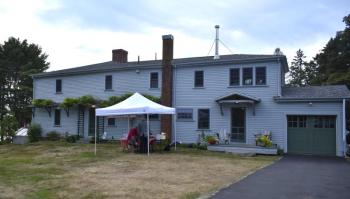 Leach House was once the site of a mid-18th-century tavern. ISABELLE CURTIS/Boothbay Register
Leach House was once the site of a mid-18th-century tavern. ISABELLE CURTIS/Boothbay Register
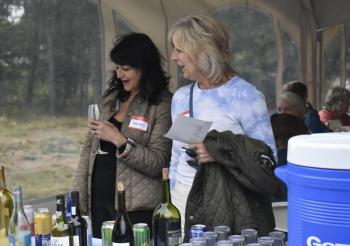 Guests got to try both typical tavern food and drink. ISABELLE CURTIS/Boothbay Register
Guests got to try both typical tavern food and drink. ISABELLE CURTIS/Boothbay Register
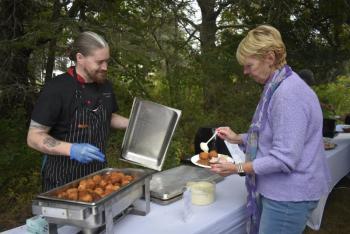 Salted cod balls! ISABELLE CURTIS/Boothbay Register
Salted cod balls! ISABELLE CURTIS/Boothbay Register
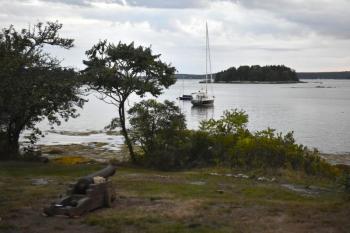 A cannon from the War of 1812. ISABELLE CURTIS/Boothbay Register
A cannon from the War of 1812. ISABELLE CURTIS/Boothbay Register
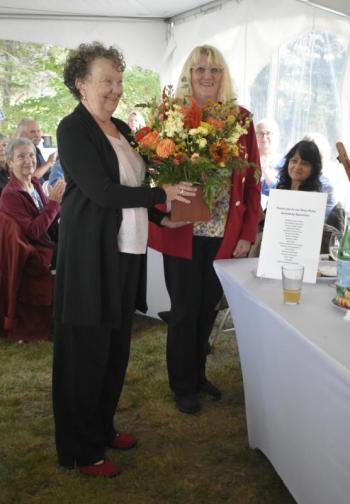 Sally Sewall receives flowers in thanks from BRHS. Pictured: Sally Sewall and BRHS Outreach and Development Manager Connie Hartley. ISABELLE CURTIS/Boothbay Register
Sally Sewall receives flowers in thanks from BRHS. Pictured: Sally Sewall and BRHS Outreach and Development Manager Connie Hartley. ISABELLE CURTIS/Boothbay Register
 Food historian Sandra Oliver talks tavern food. ISABELLE CURTIS/Boothbay Register
Food historian Sandra Oliver talks tavern food. ISABELLE CURTIS/Boothbay Register
 Archaeologist Tim Dinsmore shows off a typical 18th-century case bottle. ISABELLE CURTIS/Boothbay Register
Archaeologist Tim Dinsmore shows off a typical 18th-century case bottle. ISABELLE CURTIS/Boothbay Register
 ISABELLE CURTIS/Boothbay Register
ISABELLE CURTIS/Boothbay Register
 ISABELLE CURTIS/Boothbay Register
ISABELLE CURTIS/Boothbay Register
 ISABELLE CURTIS/Boothbay Register
ISABELLE CURTIS/Boothbay Register
 ISABELLE CURTIS/Boothbay Register
ISABELLE CURTIS/Boothbay Register
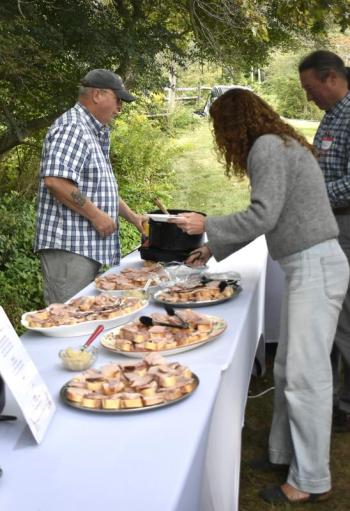 ISABELLE CURTIS/Boothbay Register
ISABELLE CURTIS/Boothbay Register
 ISABELLE CURTIS/Boothbay Register
ISABELLE CURTIS/Boothbay Register
 ISABELLE CURTIS/Boothbay Register
ISABELLE CURTIS/Boothbay Register
 ISABELLE CURTIS/Boothbay Register
ISABELLE CURTIS/Boothbay Register
 ISABELLE CURTIS/Boothbay Register
ISABELLE CURTIS/Boothbay Register
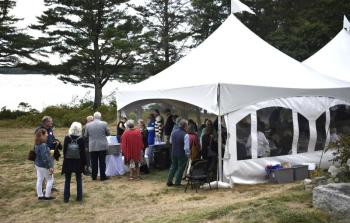 ISABELLE CURTIS/Boothbay Register
ISABELLE CURTIS/Boothbay Register
 ISABELLE CURTIS/Boothbay Register
ISABELLE CURTIS/Boothbay Register
 ISABELLE CURTIS/Boothbay Register
ISABELLE CURTIS/Boothbay Register
 ISABELLE CURTIS/Boothbay Register
ISABELLE CURTIS/Boothbay Register
 ISABELLE CURTIS/Boothbay Register
ISABELLE CURTIS/Boothbay Register
 ISABELLE CURTIS/Boothbay Register
ISABELLE CURTIS/Boothbay Register
“The past is a foreign country,” food historian Sandra Oliver told guests Sept. 13 at Boothbay Region Historical Society’s (BRHS) open house and fundraiser at Leach House (“Old Gray House”). There were about 100 people, and Outreach and Development Manager Connie Hartley said $6,000 was raised.
Attendees were offered glimpses into the strange land of the past as they toured the house, where alcoves were set up to display documents and historical artifacts from the Society's collection, from vintage photographs to pristine 19th-century dresses.
This is the third time the owner, Sally Sewall, has invited the public in to benefit the Society. Leach House has been in her family since 1918, when her grandparents, H.K. Merrow and Sarah Mclauthlin Merrow, bought the Sawyer Island property and restored it from a crumbling, squatting spot for fishermen to a private home.
“When you have a house like this, it's always filled with people. A lot of friends and family really appreciate the house and its history,” said Sewall.
History abounds on the property. According to research from local historian Barbara Rumsey, the area had an inn and tavern during the mid-1700s that welcomed locals and waterborne travelers alike. Innkeeper Benjamin Sawyer also got caught up in the excitement of the American Revolution when the Crown voided the house of its possessions and set them alight for Sawyer’s patriotism. A cannon from the War of 1812 that was found nearby now resides on the lawn.
The tavern was the focal point of the evening with a brief talk on inns' regional history from archaeologist Tim Dinsmore, who worked on the Bryant-Barker Tavern excavation in Newcastle.
“Taverns were an integral part of colonial life. They were places to conduct businesses, to settle old accounts and to shake hands on new business dealings. They were also places where one conversed about politics and local gossip, as well as places to hear from travelers of more worldly doings,” he explained.
Dinsmore pointed out, when wondering what material items were once stored at the tavern, “So much imperfect history, we only have the scraps to pull together to form a picture of colonial taverns and the people who inhabited them.”
Guests got to sample typical tavern fare, including baked beans, bread with roasted ham slices and cod balls. Most of the recipes were from Sandra Oliver’s cookbook, "Saltwater Foodways: New Englanders and Their Foods at Sea and Ashore in the 19th Century.”
However, despite being the author of several cookbooks, they aren’t Oliver’s preferred source when researching how people ate.
“Cookbooks are prescriptive literature. They describe how things are supposed to be, not how they end up,” she explained. Her interest lies in the movements of foods: What was coming up the river from other places? What was being traded down south? Household accounts also provide insight into what people were buying and consuming, whether they followed certain diets, or if they had drinking habits.
The oldest surviving Boothbay account book, kept by Joseph Patten from 1753 to 1762, was displayed. Patten bought Sawyer’s Island in 1746 and operated a store there for several years, according to the Society.
During the lecture, Oliver shared more information about the night’s menu: Ham was a common tavern food because it was easier and quicker to prepare on short notice than poultry. And traditional 19th-century sweets were introduced, including the common seafarer’s treat “plum duff," a boiled raisin pudding topped with molasses. (At the time, “plum” was a more general term to mean dried fruit.)
Oliver had a warning for the evening’s Fish House Punch: a sweet, but “lethal” cocktail. “Headache! Don't drink too much of it. I can't tell you how many parties I saw go from like zero to 95.”


